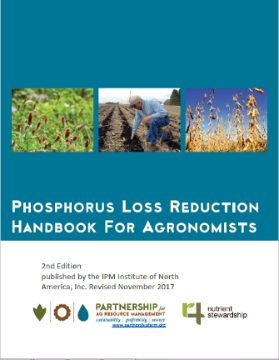Agricultural Retailers Improve Water Quality in the Great Lakes

A Note from GLPF –
It was nearly a decade ago when a team led by the IPM Institute of North America, Inc. approached the Great Lakes Protection Fund with an ambitious idea of disrupting the agricultural (ag) retailer business model in the Great Lakes region. Leading a team of ag retailers and crop advisors, farmers, watershed organizations, non-profits, and academics, IPM Institute set out to prove that retailers can make a profit selling products and services that improve water quality; and that they no longer have to be tied to a business model that relies on inefficient practices that degrade waters and lead to diminishing financial returns. At the time, this team was one of the first to consider ag retailers as a valuable ally in the fight to reduce nutrient pollution in the Great Lakes.
Guest blogger and IPM Institute team leader, Caitlin Leahy, describes here how the team took an ambitious idea and successfully tested it in the Sandusky River watershed, and then scaled it across the Great Lakes, keeping over four million pounds of phosphorus out of the Great Lakes through the sales of products and services. What I love about Caitlin’s story is that the story doesn’t end here – this is just the beginning…
— Shannon Donley, Project Implementation Manager
Agricultural Retailers Improve Water Quality in the Great Lakes
The Partnership for Ag Resource Management (PARM), a project led by the IPM Institute of North America, began as an idea in 2010 to target ag retailers as a vector for tackling record-breaking algal blooms through the innovative approach of boosting sales in products like cover crops and variable rate technology, already in ag retailer inventories. With a $622,000 grant from the Great Lakes Protection Fund (GLPF), we worked with 12 agricultural retailers in the Sandusky River Watershed in Ohio, to identify, promote, track and report on products and services that keep commercial fertilizers on fields and out of Western Lake Erie.
Dr. Thomas Green, project team leader and IPM Institute president, saw great potential in partnering with ag retailers, a group often ignored when it comes to water quality improvements. Ag retailers and co-ops, who supply farmers with fertilizer, seed and other important products and services, could potentially deliver a triple win – cleaner water, better crops for farmers and revenue opportunities for ag retailers.

In 2015, with a second investment of $759,000, the GLPF helped our project expand its reach from those first 12 retailers representing 534,000 farmer acres to 47 participants servicing over 3.8 million acres in the entire Great Lakes Basin. Impacts have grown from an estimated 220,426 pounds of phosphorus kept on cropland and out of the Basin waters in 2012, to over four million pounds in 2017 through products and services including cover crop seed and sowing services and variable rate technology (applying fertilizer where it is needed within a field versus a uniform rate across a field).

How Do We Do It?
PARM has achieved this level of success by promoting, tracking and reporting sales of ag retailer products and services that reduce nutrient losses from cropland. This is accomplished through training, communication tools, and annual surveys and reports (http://partnershipfarm.org/news-2/ ) back to participants.
With support from GLPF, we created a webinar series to increase awareness of water quality issues in the Great Lakes Basin and provide our ag retailer audience with the latest research concerning nutrient management. To date we’ve achieved over 5,800 viewers across the 15 webinars in the series. Recorded webinars are available at http://partnershipfarm.org/webinars/.
We also developed a 4R-approved Phosphorus-Loss Reduction Handbook http://partnershipfarm.org/agronomist-handbook/ and 4R nutrient-loss wallet cards http://partnershipfarm.org/p-loss-reduction-wallet-card/ to support ag retail agronomist conversations with farmer clients on how different products and services can address water quality concerns. More than 900 Handbooks have been downloaded from our website and over 25,000 cards distributed at no cost to users thanks to GLPF support.
With GLPF, we developed videos to get the word out on what retailers and their customers are doing day-to-day to benefit soil health and increase nutrient efficiency, ultimately contributing to cleaner waters. You can hear from one of PARM’s retail participants, John Meadows, crop consultant with Crop Production Services (now Nutrien Ag Solutions) in Michigan, https://www.dropbox.com/s/p3yuzox1b9i4uf3/PARM-Consultant%5BCC%5D.mp4?dl=0 and one of Nutrien’s customers, Mark Gwirtz, in Ohio: https://www.dropbox.com/s/vjuv7gsjgk8omz6/PARM-Grower%5BCC%5D.mp4?dl=0.
In summer 2018, in a co-branding initiative with GLPF, PARM partnered with Field to Market (FTM), a large multi-party collaboration focused on improving sustainability, on a project overseen by Sustainability Programming for Ag Retailers and CCAs (SPARC) with members including the Environmental Defense Fund, Agricultural Retailers Association, American Society of Agronomy and FTM itself. The project created online courses for ag retailer managers on opportunities in sustainability. The courses offer continuing education units for Certified Crop Advisors and certificates for managers, and are housed on the American Society of Agronomy website under Sustainability 101 https://www.certifiedcropadviser.org/education/classroom/classes/by-category#category11.
Expanding the Partnership
We currently have over 80 participants in both the Great Lakes and Mississippi River Basins representing over 4.7 million acres, and additional support from the US EPA Great Lakes Restoration Initiative, the McKnight Foundation and the Clean Lakes Alliance, as well as memberships and sponsorships from participating ag retailers, manufacturers and distributors.
GLPF gave us the opportunity to test a concept and then scale up, to engage ag retailers and co-ops to tackle water quality challenges with a market-based solution. Our project has gained national recognition, an accomplishment that would not have been possible without the active support of participating ag retailers and our GLPF partner.
–GLPF wishes to thank Caitlin Leahy of the IPM Institute of North America for this post.
